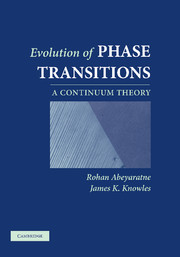Book contents
- Frontmatter
- Contents
- Preface
- Part I Introduction
- Part II Purely Mechanical Theory
- Part III Thermomechanical Theory
- 5 Multiple-Well Free Energy Potentials
- 6 The Continuum Theory of Driving Force
- 7 Thermoelastic Materials
- 8 Kinetics and Nucleation
- Part IV One-Dimensional Thermoelastic Theory and Problems
- Part V Higher Dimensional Problems
- Author Index
- Subject Index
6 - The Continuum Theory of Driving Force
Published online by Cambridge University Press: 12 August 2009
- Frontmatter
- Contents
- Preface
- Part I Introduction
- Part II Purely Mechanical Theory
- Part III Thermomechanical Theory
- 5 Multiple-Well Free Energy Potentials
- 6 The Continuum Theory of Driving Force
- 7 Thermoelastic Materials
- 8 Kinetics and Nucleation
- Part IV One-Dimensional Thermoelastic Theory and Problems
- Part V Higher Dimensional Problems
- Author Index
- Subject Index
Summary
Introduction
In the present chapter, we consider a continuum in which there are three-dimensional, thermomechanical fields involving moving surfaces of discontinuity in strain, particle velocity, and temperature. Our objective is to set out the theory of driving force acting on such surfaces without specifying any particular constitutive law. The theory should be applicable to physical settings ranging from the quasistatic response of solids under slow thermal or mechanical loading in which heat conduction is present, to fast adiabatic processes in which temperature need not be continuous and inertia must be taken into account. The theory must be general enough to accommodate such disparate settings.
We begin by stating the fundamental balance laws for momentum and energy in their global form. These laws are then localized where the fields are smooth, leading to the basic field equations of the theory. Localization of the global laws at points where the thermomechanical fields suffer jump discontinuities provides the jump conditions appropriate to such discontinuities.
Without making constitutive assumptions, we then introduce the notion of driving force. The driving force arises through consideration of the entropy production rate associated with the thermomechanical fields under study; it leads to a succinct statement of the implication of the second law of thermodynamics for moving surfaces of discontinuity.
The theory is developed for three space dimensions in Lagrangian, or material, form, according to which one follows the evolution of fields attached to a given particle of the continuum.
- Type
- Chapter
- Information
- Evolution of Phase TransitionsA Continuum Theory, pp. 105 - 112Publisher: Cambridge University PressPrint publication year: 2006

